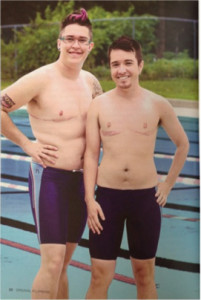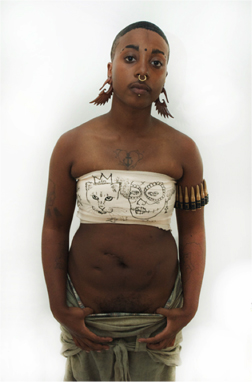From Rayon to Original Plumbing:
A brief reflection on representations of trans* people in U.S. Culture today
Ace Lehner
From Laverne Cox on the cover of TIME magazine to Jared Leto’s portrayal of Rayon in Dallas Buyers Club, the United States saw an unprecedented number of trans* people in popular culture in 2014. 1 While many heralded this as a marker of progress, increased representation does not necessarily correlate to any positive change in peoples’ lives. However, for my purposes here, rather than focus on how trans* representations in popular culture often reinforce stereotypes, undermine political struggles and endanger people, I will discuss depictions of trans* people that I find to be fecund and multidimensional. Original Plumbing: Trans Male Quarterly is a project that presents trans*men as diverse, self-assured and attractive and is a necessary counterpoint to the problematic depictions of trans* people in mainstream culture.2
Printed full bleed on the 5.5” x 8” full color, semi gloss page is a picture of two fair-skinned topless trans*men in front of a swimming pool. They stand close together, smile, engage the camera directly, each with a hand on a hip and appear genuinely happy. This is a picture that accompanies the story Pool Boys, in the “Jock Issue” of Original Plumbing. The image is one of many full bleed spreads in the portrait-driven zine. Published quarterly, bound by two staples and ranging in thickness from around 60-70 pages per issue, Original Plumbing launched in 2009 by Rocco Kayiatos and Amos Mac, (both self-identified transmen) is a publication that predominantly depicts trans*men but often features trans*women and other members of the queer community.
Jacsen Callahan and Nico Amador, as depicted here represent a moment post top surgery when their scars are still very visible and their bodies exist in a state that does not fit neatly within the typical masculine form. Rather than think through scars as a site of injury, pain or trauma what these top surgery scars mark is the longed for and now present chest supplanting the burden of breasts. Thinking of these scars as an embodiment of a welcome presence rather than an absence or injury reframes our relationship to viewing scars in a way that we understand them as a source of pride rather than the perhaps more typical way of encountering scars as an embodiment of pain.
The article is a conversation between self-identified boyfriends Jacsen Callahan and Nico Amador. In the conversation Callahan refers to himself as being queeny and they both refer to themselves as queer. 3 In this depiction we see embodiments that visually propose a way of being in between binary notions of biological sex and binary representations of gender. In some ways this picture of Jacsen and Nico represents trans* embodiment in all their transgressive potential, disrupting the gender binary. 4 The narrative combined with the images also disrupts the assumption that transitioning necessarily implies heterosexuality. But the bodies remain those of pale, white, queeny jocks, embodiments that are met with a certain type of privilege.
Since its inception the publication has solicited content from its readers and has now expanded into a website, both moves that allow for a great diversity of representations. As a project, Original Plumbing includes multiple perspectives, various formats of representations, and provides narratives other than that of the “trapped in the wrong body” narrative of trans* experiences perpetuated by popular representation of trans* people. Many of the subjects are photographed by Amos Mac (a freelance photographer) and generally speaking, are depicted in a way that renders them sexually desirable –something rarely seen by representations of trans* folks in mainstream media. The magazine has been organized thematically and issues have dealt with Health & Safer Sex, Workin’ Stiff, Fashion, The Family Issue, The Jock Issue, The Hero Issue, and the Selfie Issue. “Original Plumbing” as a title along with each issue’s title does a lot of work to outline the publication’s commitments. 5
In the Fashion Issue we are introduced to various trans*men through full bleed photo spreads shot by Mac and accompanied by interviews. Some of the men 6 pass and don styles that they self-describe as “classic,” “rockabilly,” and “dandy” and others like Sanyu describes their style as being “Tank Girl as boi meets Mursi tribe of Ethiopia.” 7 The issue suggests that there are many ways trans*men embody fashion. The profile of Sanyu raises questions about trans* masculinity connected to ability as well as a racialized body. What real life challenges come with being trans*masculine and African American? How might Sanyu’s life as a trans* man differ from that of the passing white looking “rockabilly” trans*man? Or how might they both differ from the gay orientated “Pool Boys”? Original Plumbing seems to beg us to ask these and other questions about our own understandings of masculinity and gender and to consider building community across differences.
Scholar and self-identified trans*man Kai M. Green writes, “The world is unkind to Black bois. The world is unkind to Black girls. But the way our gendered bodies are policed is different.”8 While the policing of bodies is real and dangerous there are also many other ways in which the racial implications of being trans* can be insidious and dangerous.9 The appearance of reductive representations of trans* bodies in popular visual culture masks the diversity of what trans* lives are like and often skirts around the networks of oppression at work in regulating trans folks and particularly those who exist at the intersection of multiple oppressions.
José Esteban Muñoz a scholar used the term autoethnographic to describe cultural performances that put marginalized personal histories into the public sphere.10 Borrowing from Muñoz, I propose that Original Plumbing expands the autoethnographic by including interviews between trans*men, self-portraits and first person narratives and that this is precisely why it is a necessary mode of cultural production. These hybrid-autoethnographic forms are present even when Amos Mac is photographing subjects for as a transman himself Mac has a level of understanding and kinship for the trans* subjects he photographs.
When trans* people appear in visual culture it is crucial to be critically engaged in how these depictions may impact lived experiences. Original Plumbing remains an important site of cultural production and also reflects a moment and space within queer communities where through hybrid-autoethnographic production complex representations are created and potential for coalition building across differences is proposed.
Return to author’s page
Return to Theme Content
notes
- The June 9, 2014 cover of TIME magazine featured Lavern Cox as the cover image and was accompanied by the feature story “The Transgender Tipping Point: America’s next Civil Rights Frontier.” 2014 was also the year when Barney’s New York’s 2014 Spring Add campaign was lauded for featuring seventeen trans* models, also this year Netflix launched the original series Transparent and earlier this year Jared Leto appeared in Dallas Buyers Club as Rayon an ambiguously gendered / potentially trans* woman. The role garnered him high acclaim and awards for his portrayal. ↩
- Green, B. (2013). Literacy, rurality, education: A partial mapping. In B. Green & M. Corbett (Eds.), Rethinking Rural Literacies: Transnational Perspectives (pp. 17–34). New York, NY: Palgrave-Macmillan ↩
- Jacsen Callahan and Nico Amador, “Pool Boys,” Original Plumbing: Trans Male Quarterly, #10 The Jock Issue, 23-25. ↩
- Within trans* scholarship and discourse there has been debate about the notion of beyond the binary but this politics may also prove problematic if it does not allow for those trans folks who are interested in presenting as within the gender binary to embody gender binary identities. This picture allows for a complex embodiment that complicates theory by being present in a state of transition that is visually read as such by some and not by other viewers. ↩
- “Original plumbing” as a term is an euphemism made popular by the personal adds on craigslist to describe a trans* person who has the genitals they was born with. This points to a trend in culture where in cis (or non trans people) and those not familiar with trans* people often immediately ask questions of trans* people regarding the state of their genitalia. Giving a nod to the culture of craigslist personals where people talk openly about their sexual desire for men with vaginas, and using a term that also references a working class profession. ↩
- By “pass” I mean fully engender and embody aspects of masculinity that render the subject as biologically male or cis gendered to everyone around them. ↩
- “Style Profiles,” Original Plumbing: Trans Male Quarterly, #5 Fashion Issue, 14-24. The profile of Sanyu is on page 16. ↩
- Kai M. Green, “Navigating Masculinity as a Black Transman: “I will never straighten out my wrist,” Everday Feminism, December 5, 2014 (thttp://everydayfeminism.com/2013/04/i-will-never-straighten-out-my-wrist/). ↩
- Here I’m thinking about the countless people who have been profiled, attacked, injured and murdered because their embodiments engender visually recognizable aspects that mark hem as targets for various forms of oppression. Certainly folks like CeC McDonald and others who also don’t neatly fit into predetermined categories and/or stereotypes. ↩
- Muñoz, José Esteban. Disidentifications: Queers of Color and the Performance of Politics. Minneapolis: University of Minnesota Press, 1999, 81-82. ↩


